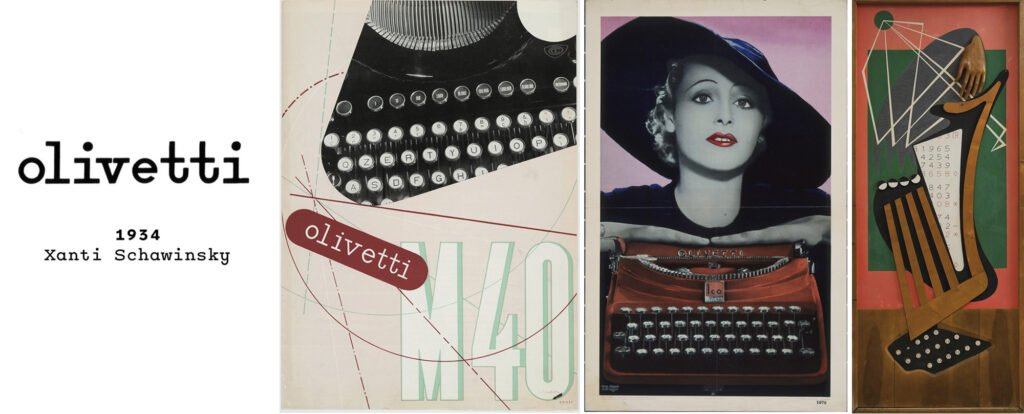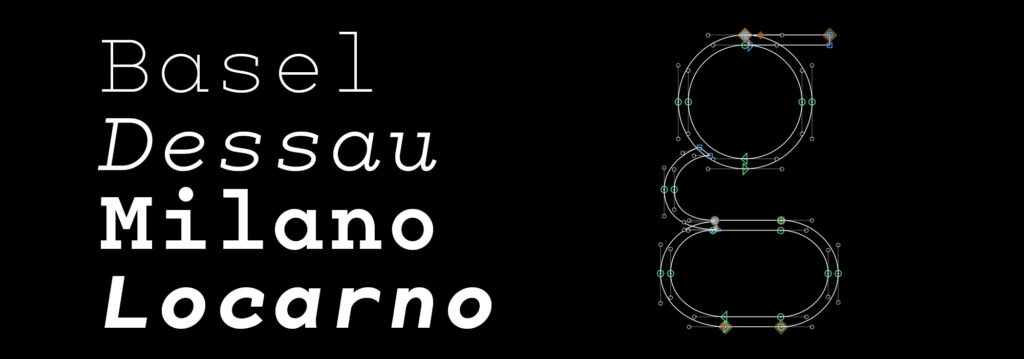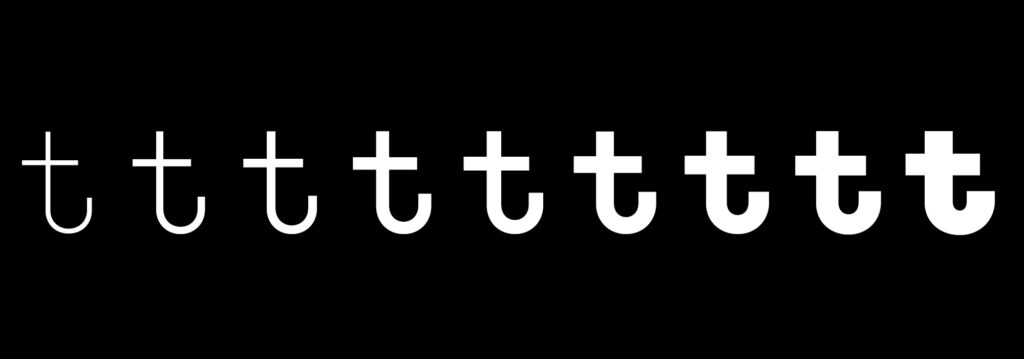Interview by Massimo Gonzato
The launch of Xanti Typewriter comes after Iki Mono by Beatrice D’Agostino and Divenire Mono, recently added by Luciano Perondi. Though typewriters went the way of the dodo decades ago, there can be no doubt that monospaced faces are here to stay. Let’s talk about CAST’s latest release with the designer, Gianluca Sandrone.
How would you define Xanti Typewriter?
It’s a monospaced type family strongly influenced by Bauhaus geometric typography.
What does ‘Xanti’ mean?
Among the objects in the studio where I’ve been working for some years, there’s an Olivetti M40 typewriter with the company logo stamped on it. It was designed by Alexander ‘Xanti’ Schawinsky, a Bauhaus disciple and a close friend of Herbert Bayer who lived and worked in Italy from 1933 to 1935. On this logo (probably less renowned than later logos designed by Giovanni Pintori and Marcello Nizzoli) I based my design. I’m really grateful to Daniel Schawinsky who allowed me to use his father’s name for my typeface.

Top: Oskar Schlemmer’s Triadisches Ballett, photo by Ernst Schneider, 1927.
Xanti Typewriter’s starting point is a Bauhaus-like logo from the mid-1930s. Would you consider it a type revival?
Schawinsky’s letterforms are very stylish, they contain unusual details and they also echo Herbert Bayer’s masterpiece, Universal: geometrical construction, symmetrical design principle, and circular forms… I’ve always been fascinated by this experimental typeface that was never actually cast into real type. By the way, Schawinsky’s design was just an inspiring model for me.
Xanti Typewriter cannot be defined as a type revival. My goal was to walk a little-travelled path, in search of a unique design based on the peculiarity of the source. Starting from an existing logo and extending its design to all the other letters is a game that I had already played. And this gave me the confidence I needed to tackle the Xanti project, even though I was well aware that much time and energy would be necessary.

What are Xanti Typewriter’s main features and purposes?
Its x-height grows with the overall boldness of each style. By increasing the weight of letters, almost each glyph loses its serifs depending on the overall shape complexity. So we can define Xanti Typewriter as a hybrid between a slab serif and a sans serif. The serifs have been kept until there was enough white space to keep the pure, geometrical and almost brutalist design consistency. This design decision allowed Xanti Typewriter to become a type family and to cover a wide range of applications, from packaging to editorial design and coding.

You got an MA in Communication and graphic design at ISIA Urbino. What sparked your interest in typeface design?
I completed the bachelor course in Industrial Design at the Politecnico di Torino. In those years I had my first experiences in the graphic design field at LaMatilde, a Turin design studio. Far away from the university I started collecting typefaces from the web as if they were stickers. Even before I knew anything about typefaces, they fascinated me. I don’t know why. I can only say that my first approach to typeface design was totally self-taught. Only later I did enrol at ISIA Urbino and I began to explore this world with more awareness.
When did you start designing Xanti Typewriter?
Almost two years ago; thanks to a whole series of circumstances, not least the pandemic, I made the first sketches of the face and I just went on. Last year, I showed my project to Luciano Perondi and he was enthusiastic about it. So we started editing Xanti Typewriter to improve consistency and refine details. The first rough ideas went in the direction of sans serif but, after many discussions we decided to go back to the original model, and the end result was this monospaced face with eight weights and matching italics. I hope our efforts will be enjoyed.

Is Xanti Typewriter your first typeface? How come you released it through CAST Foundry?
Releasing Xanti Typewriter with CAST is not by chance. Eight years ago, at ISIA Urbino, the first person who inspired me on my new design path was Luciano, who at the time was head of the school.
I have already designed other typefaces which were included in visual identities, competitions and editorial projects… They were almost exclusively display faces created together with Marco Tortoioli Ricci and BCPT Associati and for Mauro Bubbico.
Xanti Typewriter is the first typeface I have released. Previously I hadn’t managed getting that far because, as anyone in the field knows well, designing a type family with different and complementary weights and styles, requires a lot of time and a lot of effort. Though it is fully equipped to cover a wide range of applications, I’m looking forward to expanding the current monospaced family by designing the sans version.

Schawinsky: a profile
Hard to be categorised, Xanti Schawinsky’s body of work includes every kind of media. An all round designer tackling products, interior and exhibition spaces as well as visuals for advertising campaigns. He was a very close friend of Herbert Bayer and Marcel Breuer. In his typographic approach, the influence of Bauhaus masters can be clearly recognised.

Painter, photographer, graphic and theatre designer Alexander ‘Xanti’ Schawinsky was born in Basel, Switzerland, on March 25, 1904, to a Jewish family of Polish descent. He enrolled in the Bauhaus in Weimar in 1924. Paul Klee, Wassily Kandinsky, Adolf Meyer, Oskar Schlemmer and László Moholy-Nagy were among his teachers. In 1925, Schawinsky moved to the Bauhaus Dessau, focusing on experimental photography. From 1926 to 1927 he designed stage sets in Zwickau, and taught as an assistant to Schlemmer in stage design at the Bauhaus. He also began to devote himself to painting. In 1929 Schawinsky went to Magdeburg to head the graphic department of the municipal building authority.
Due to political and antisemitic hostility, in 1933 Schawinsky left Magdeburg and moved to Italy. In Milan he worked for the Studio Boggeri, the newly founded state-of-the art advertising studio. He designed outstanding posters and product designs for Motta, Illy coffee and Cinzano. Working at Olivetti he co-designed Studio 42, a new professional typewriter. Olivetti also consulted him for their new head offices. In 1935 the political situation forced him to leave Italy and to settle in London.
In 1936 he was invited to teach at the Black Mountain College in North Carolina, USA. In 1938 he left the college and designed the North Carolina Pavilion at the 1939 New York World’s Fair and, with Breuer and Gropius, the Pennsylvania Pavilion. He taught at the City College of New York from 1943 to 1946 and at New York University from 1950 to 1954.
From 1961 Schawinsky travelled for longer periods to Europe, building a second home in Oggebbio on Lake Maggiore, Piedmont, Italy. He designed the architecture and interiors by himself under Marcel Breuer’s supervision. Breuer also certified the building as a classic Bauhaus architecture. Schawinsky died on 11 September 1979 in Locarno, Switzerland.

